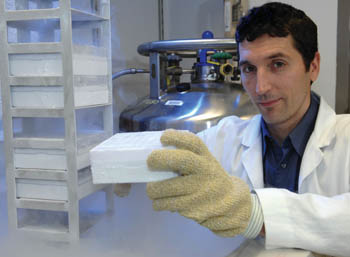
Eric Sebzda, Ph.D. (photo by Neil Brake)
A closer look into the immune system's playbook
If we consider the cells of the immune system as a football team, the T-lymphocyte, or T-cell, could be described as the “quarterback, coordinating everything,” says Eric Sebzda, Ph.D.
Sebzda, a recent recruit to Vanderbilt's Department of Microbiology and Immunology, has now deciphered a page from their playbook, showing how a cellular protein called Klf2, helps direct the proper migration of T-cells.
Born in the bone marrow and matured in the thymus (hence their abbreviated moniker), T-cells survey the body for foreign, or “non-self,” invaders like pathogens or tumor cells. In a healthy individual, unactivated, or naïve, T-cells circulate in a closed loop between the blood and the secondary lymphoid organs (spleen and lymph nodes).
Once an individual becomes infected with a pathogen, T-cells become activated, proliferate and exit this closed loop to enter the peripheral tissues so they can clear the infection from its original site.
“When a T-cell becomes activated, it somehow changes the way it circulates to move off to peripheral tissues to do its business,” said Sebzda. “So there is an intrinsic difference in the way a naïve T-cell circulates versus that of an activated T-cell. How that happens wasn't known. And that's where Klf2 comes in.”
Sebzda joined the Vanderbilt faculty in October after working as a post-doctoral fellow at the University of Pennsylvania in Philadelphia. There he had initiated research focusing on the role of a transcription factor, Klf2, in T-cell activation and migration.
Mice deficient for Klf2 die very early due to vascular defects. Therefore, Sebzda and colleagues generated mice that had Klf2 specifically deleted in T-cells. Previous work had shown that while maturing T-cells did not require Klf2 within the thymus, unactivated Klf2-deficient T-cells were largely absent from the “closed-loop” circulation. The few remaining T-cells in these mice appeared to be activated and dying.
“That was really a strange phenotype,” said Sebzda. “It suggested that you have to actively keep cells quiet (or unactivated), and you'd think it would be just the opposite.”
In work published in Nature Immunology, Sebzda and colleagues report that in the absence of Klf2, naïve T-cells act like activated T-cells, migrating to peripheral tissues where they wouldn't normally be.
“It's not that T-cells are absent in Klf2-deficient animals — people simply missed them because they were looking at the wrong tissues,” he said. “If I'm looking for T-cells in a normal mouse, I'll typically take a spleen or look at the lymph nodes. In this animal, they're just not where you'd expect to find them.”
Each white blood cell lineage migrates in a distinct circulation pattern governed by its unique expression of chemokine receptors on its cell surface — for example, a naïve T-cell typically expresses a limited set of “homeostatic” chemokine receptors on its cell surface whereas an activated T-cell may express a series of “inflammatory” chemokine receptors that encourage these cells to enter peripheral tissues.
In his recent work, Sebzda found that in the absence of Klf2, naïve T-cells were now expressing a large variety of “inflammatory” chemokine receptors.
Sebzda said, “It almost seems as if — and this is one of the things we want to determine — Klf2 normally represses a whole series of inflammatory chemokine receptors.”
Sebzda is now focusing his efforts to determine how Klf2 acts as a global repressor of chemokine receptors, whether all receptors are involved in causing this bizarre T-cell phenotype, and what effect this aberrant migration has on the immune system.
“We've got a mouse model set up, we have a pretty good idea of how it's working, but the actual immunological ramifications — nothing is known about it.”













